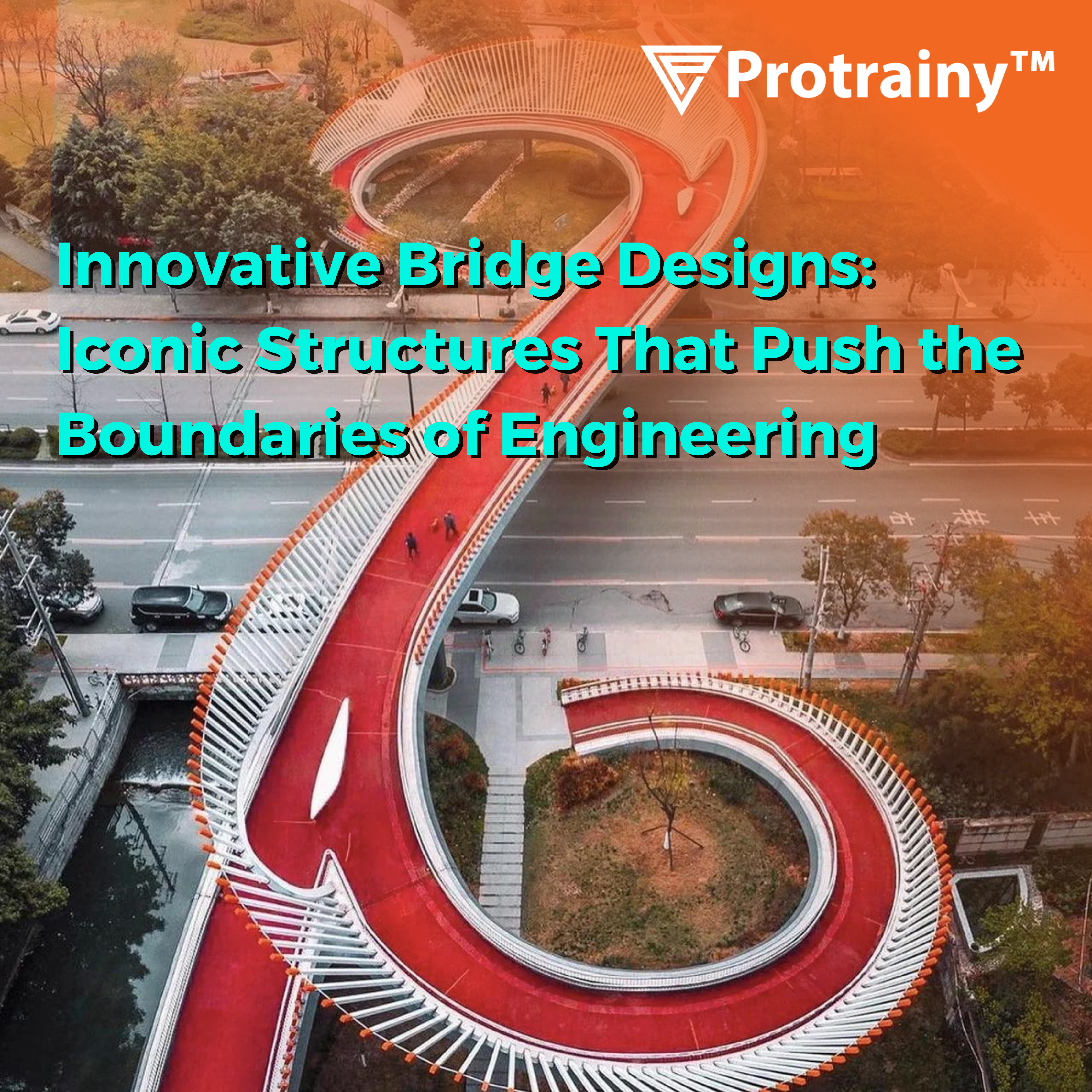Blogs
- Home
- Blogs
Innovative Bridge Designs: Iconic Structures That Push the Boundaries of Engineering
Protrainy | Aug. 25, 2023, 9:05 a.m.

Bridges are not just functional structures that connect two points; they are feats of engineering that reflect human creativity, innovation, and the desire to overcome geographical challenges. Throughout history, engineers have continually pushed the boundaries of design, materials, and construction techniques to create bridges that are not only functional but also iconic landmarks. In this blog, we will explore some of the most innovative bridge designs that have redefined the possibilities of engineering and left a lasting impact on the world.
1. The Millau Viaduct: Soaring Elegance
The Millau Viaduct in France stands as a testament to the ingenuity of modern bridge design. Spanning the Tarn River Gorge, this cable-stayed bridge holds the record for the tallest bridge pylon, with one pylon reaching a height of 343 meters (1,125 feet). The bridge's slender, curving form and use of high-strength concrete and innovative stay-cable technology not only minimize its visual impact on the landscape but also demonstrate the potential of combining aesthetics and engineering.
2. The Akashi Kaikyō Bridge: Connecting Land and Sea
The Akashi Kaikyō Bridge, also known as the Pearl Bridge, in Japan is a marvel of both engineering and resilience. Spanning the Akashi Strait, which is prone to typhoons and earthquakes, this suspension bridge is the longest central span in the world, measuring 1,991 meters (6,532 feet). Its innovative design includes pendulum bearings to absorb seismic forces and flexible expansion joints to accommodate temperature variations. The bridge's ability to withstand extreme natural forces while maintaining its functionality showcases the mastery of engineering.
3. The Gateshead Millennium Bridge: A Dynamic Sculpture
The Gateshead Millennium Bridge in the United Kingdom is more than just a pedestrian and cyclist crossing; it's a living piece of art. This tilting bridge, often referred to as the "Blinking Eye Bridge," employs a unique design that allows it to pivot on its axis to accommodate boat traffic on the River Tyne. Its innovative use of hydraulics and aesthetics seamlessly blend form and function, demonstrating how bridges can contribute to the cultural and architectural identity of a city.
4. The Siduhe Bridge: Defying Heights
China's Siduhe Bridge holds the distinction of being the highest bridge in the world. Crossing the Sidu River Gorge, this suspension bridge boasts towering towers and a breathtaking height of 900 meters (2,953 feet). Its innovative design addresses the challenges of extreme elevation and harsh climatic conditions. The bridge's success lies not only in its engineering excellence but also in its ability to provide a vital link for remote communities.
5. The Golden Gate Bridge: A Timeless Marvel
The Golden Gate Bridge in San Francisco, USA, remains an enduring symbol of both engineering prowess and aesthetic beauty. Its distinctive International Orange color and Art Deco elements make it instantly recognizable. At the time of its construction in the 1930s, its suspension span was the longest in the world. The innovative use of suspension cables, continuous truss design, and seismic retrofitting techniques have allowed this iconic bridge to stand the test of time.
6. The Øresund Bridge: A Multimodal Marvel
The Øresund Bridge, connecting Denmark and Sweden, is a remarkable example of combining road and rail transportation in a single structure. This cable-stayed bridge includes a submerged tunnel and an artificial island to accommodate both trains and vehicles. Its innovative design not only enhances transportation efficiency but also promotes international connectivity.
7. The Rialto Bridge: Timeless Elegance
While many innovative bridge designs are modern marvels, the Rialto Bridge in Venice, Italy, demonstrates that timeless elegance can also be revolutionary. Built in the 16th century, this stone arch bridge is a testament to the genius of Renaissance engineering. Its single central span was a daring feat at the time, and its enduring charm continues to inspire architects and engineers today.
Conclusion: Engineering as an Art of Possibility
Innovative bridge designs are more than just feats of engineering; they are expressions of human creativity, adaptability, and the relentless pursuit of pushing boundaries. These structures not only connect geographical points but also connect us to the marvels of human ingenuity. As we continue to explore new materials, advanced construction techniques, and sustainable design principles, the future of bridge engineering promises even more groundbreaking structures that redefine our understanding of what is possible. These iconic bridges remind us that the world of engineering is an art of possibility, where imagination knows no limits.
